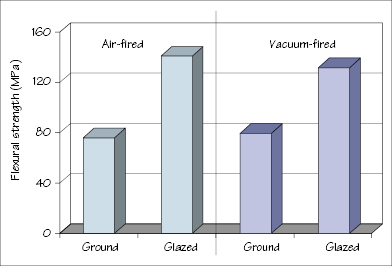39
Manipulation and properties of porcelain
Figure 39.1 Effect of surface condition and firing regimen on porcelain strength.

Box 39.1 Condensation methods for porcelain slurries
Blotting with a brush or 2 × 2 gauze
Mechanically, by vibration or tapping—latter not recommended
Addition of dry powder to surface
Water addition (gravitation method)—not recommended
Table 39.1 Factors in sintering
| Sintering factor | Effect |
|---|---|
| Temperature | Determines glass flow and firing shrinkage. |
| Glass viscosity | Lower viscosity improves flow of glass during sintering. |
| Particle size | Range of particle sizes reduces void space; smaller particle sizes increase interparticle contact and more uniform surfaces; affects firing shrinkage. |
| Surface tension | High surface tension increases flow and bridge formation during sintering. |
| Air pressure | Increases density by removing air in voids under reduced pressure. |
Table 39.2 Stages in firing of porcelain
| Firing stage | Effect of firing |
|---|---|
| Low bisque | Removal of organic matter but minimal shrinkage |
| Medium bisque | Flux flow and shrinkage |
| High bisque | Complete vitrification and surface smoothing |
| Glazing |
Stay updated, free dental videos. Join our Telegram channel

VIDEdental - Online dental courses


